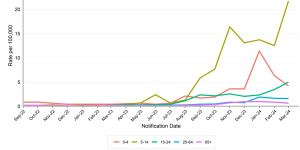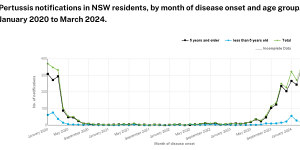Whooping cough diagnoses,which dropped dramatically during the pandemic,surged in school-aged children during the first quarter of this year,NSW Health data published on Thursday showed.

The biggest increase in cases has been among school-aged children between five and 14.NSW Health
Infectious diseases expert Professor Robert Booy said a gradual rise in cases,particularly in children,since September had been driven by people mixing during summer holiday events,the return to school and lowered immunity due to a lack of exposure to the infection during the pandemic.
“There’s been a lot of transmission among primary school-aged kids because they’ve gone to school with a cough,and they’ve spread it. It’s a really strong spreader,it’s very transmissible.
“For every one child infected,more than 10 can develop a secondary infection. We’re due an outbreak,and we’re due a moderately big one.”
The state recorded a rate of 47 whooping cough notifications per 100,000 people to March 28,up from a rate of 11 cases per 100,000 people for all of 2023. This was compared to rates of 0.5 notifications per 100,000 people in 2021,and one case recorded per 100,000 people in 2022.
The biggest increase in cases was detected among young people aged five to 14 in the past month,when the rate nearly doubled from about 12 cases,to roughly 23 notifications,per 100,000 children.
Whooping cough,or pertussis,is an extremely contagious respiratory illness caused by a bacterial infection. The infection causes a long coughing illness which can be life-threatening for babies.
Booy said parents should keep children home from school until their symptoms subsided. He said anyone who wanted to evade the infection should avoid people with a chronic cough,wear a mask in crowded areas such as public transport,and ensure their whooping cough vaccines were up to date.
Australian Medical Association NSW president Dr Michael Bonning said it was too early in the year to predict whether rates of the infection,which was often seasonal,would continue to rise in NSW.

Rates of whooping cough were low during the COVID-19 pandemic.NSW Health
“The rate of 47[cases] per 100,000[people] is still well below where we’ve seen other years. We’ve seen years that are four times that – the rate was 180 per 100,000 in 2011.
“The reassuring thing is we are still seeing really low rates among young children under the age of five,where whooping cough is most risky and most dangerous,” Bonning said.
Bonning also urged parents to make sure their school-aged children,who might have missed a jab during the pandemic,were up to date with their whooping cough vaccinations.
“Every pregnant woman should receive a dose of a pertussis-containing vaccine in each pregnancy,and anyone who will be in close contact with a newborn infant should check their pertussis vaccination history because the most at risk are newborns and very young children.”
He said people aged 65 and older were recommended to have a pertussis-containing vaccine if their last dose was more than 10 years ago.
“Making sure people are covered in their older age is important,especially because there is a reasonable amount of it in the community.”
